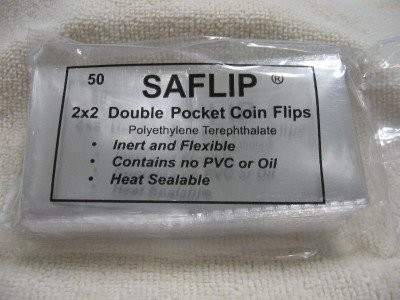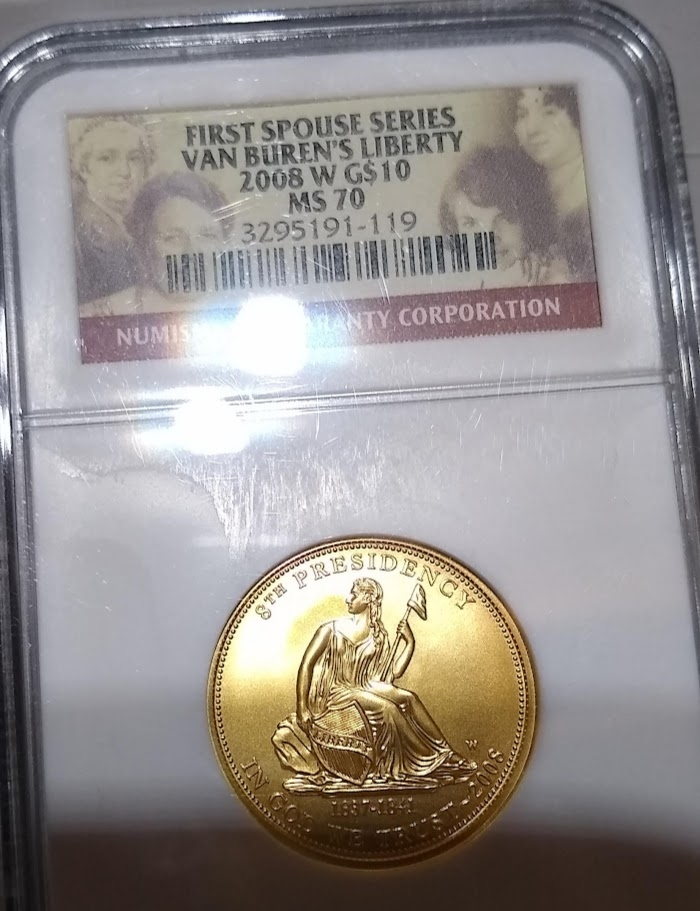Why do Mylar coin sleeves have an oily look (aka "newton ring" effect)?
 WildWestHalfDollars
Posts: 6,775 ✭✭✭✭✭
WildWestHalfDollars
Posts: 6,775 ✭✭✭✭✭
I was storing some coins today all have been bathed in acetone and rinsed then dried for days. I closed some of Mylars and some areas look oily (shines like an oil spill). I use Saflips made in USA only.

I prefer collecting coins in lower circulated condition G04 to F12
0
Comments
It can be anywhere in the flips not just were the coin ''sits''. I use nitrile gloves when doing this.
I prefer collecting coins in lower circulated condition G04 to F12
do they feel oily?
No....could it be from the nitrile gloves coming into contact with them?
I prefer collecting coins in lower circulated condition G04 to F12
AI response:
Saflips and the "Newton's Ring" Effect
Saflips are designed to protect coins from damage and moisture, and are often made of Mylar.
When a Saflip is pressed against a coin, or when the Saflip is pressed together with its packaging, a similar visual effect to Newton's rings can sometimes appear.
This effect is not a true Newton's ring, but rather a visual illusion caused by the pressure of the Saflip against the coin or the packaging, creating a slightly concave surface that refracts light.
It's important to distinguish between a genuine Newton's ring and the visual illusion created by Saflips, as the illusion is not caused by an optical phenomenon.
In summary:
While Saflips can create a visual effect that is mistakenly identified as Newton's rings, they are not the same thing. Newton's rings are an optical interference phenomenon, while the Saflip effect is a visual illusion caused by pressure and refraction of light.
I prefer collecting coins in lower circulated condition G04 to F12
I guess based on AI answer this is normal.
I prefer collecting coins in lower circulated condition G04 to F12
i was thinking maybe variations in the plastic
it's take cutting a couple that show the effect apart and see if they have the same pattern when lying flat
They are the bigger ones I purchased by mistake 2.5 by 2.5 the 2 by 2 so far does not give this effect or that I have noticed anyways. I could be wrong maybe they both do this since I use so few. I was in the process of putting all my raw coins in them (Saflips) but now need to order the 2 by 2's. The ones I have are to large.
It is not oil they are as dry as can be.
I prefer collecting coins in lower circulated condition G04 to F12
Mylar currency sleeves show the same effect.
i had to ask first as a matter of thoroughness
You're exactly right @Early_Milled_Latin_America !
If you hold these 2 1/2 x 2 1/2 flips a certain way, it looks like there is oil or some kind of moisture on the inside pocket.
Disclaimer: I'm not a dealer, trader, grader, investor or professional numismatist. I'm just a hobbyist. (To protect me but mostly you! 🤣 )
Good capture of the effect.
It's not oil or moisture, though.
Yes, on behalf of our coin........I hope you're right. 🥳 😉
Disclaimer: I'm not a dealer, trader, grader, investor or professional numismatist. I'm just a hobbyist. (To protect me but mostly you! 🤣 )
I am sure my silver coins will be just fine.
I prefer collecting coins in lower circulated condition G04 to F12
I've seen a similar effect on some older slabs from a certain TPG.

And the haze on the inside - whatever it is, is a distraction.
.
Indeed these flips are dry like a desert. No moisture or oil that is for sure.
I prefer collecting coins in lower circulated condition G04 to F12
It's optical interference between the two surfaces. That is what Newton rings are. It has nothing to do with oil or liquid other than you can create the effect with the two surfaces of a liquid like oil.
All comments reflect the opinion of the author, even when irrefutably accurate.
I guess that works for me. Do you mean Newton's Laws?
However, these flips are polyethylene right? Isn't polyethylene a petroleum product?
Disclaimer: I'm not a dealer, trader, grader, investor or professional numismatist. I'm just a hobbyist. (To protect me but mostly you! 🤣 )
That AI answer is completely wrong. The effect is just the same as Newton's Rings. You can get a very thin gap between the Mylar layers, so thin that it is only a few times the wavelength of light. Then you get light reflecting off of both Mylar layers, and you get a phase difference in the light reflections, since one reflection had to travel a little bit farther (the thickness of the gap), and the waves in the two reflections interfere, and this depends on the color of light, and then some colors are increased and some decreased, giving the rainbow effect.
An oil slick on water gets its rainbow colors in a very similar way, in that case there is a light reflection off the top of the oil slick plus one on the bottom of the slick, and you get a similar optical interference pattern.
But with the Mylar flips, there is no oil, just empty space, so there is nothing to worry about.
FWIW the colors in toning come from the same kind of phenomenon.
Sorry. Newton rings.
All plastics are essentially "petroleum products". That's not the same as actually being an oil. Your nylon underwear is an oil product. Do you feel slippery? 😀
All comments reflect the opinion of the author, even when irrefutably accurate.
LoL!! Good point! 🤣 😉
Disclaimer: I'm not a dealer, trader, grader, investor or professional numismatist. I'm just a hobbyist. (To protect me but mostly you! 🤣 )
Thanks guys!!!
I prefer collecting coins in lower circulated condition G04 to F12
They are mylar and totally inert.
Worry is the interest you pay on a debt you may not owe.
"Paper money eventually returns to its intrinsic value---zero."----Voltaire
"Everything you say should be true, but not everything true should be said."----Voltaire
Roger that @PerryHall Thanks!
Disclaimer: I'm not a dealer, trader, grader, investor or professional numismatist. I'm just a hobbyist. (To protect me but mostly you! 🤣 )
i needed you a few years ago. the forum needs you.
the proof sets come in a flat plastic with moulded cups for the coins, and that is inside the hard plastic lens.
we have a well known forumite who thinks this effect inside the lenses is due to some type of contamination. i've personally opened the lenses and confirmed they are dry (felt with fingers, swiped with paper towel) and contaminant free. that thread is why i purposefully asked about oil.
the forumite remains unconvinced it is interference and has threatened anyone who sells him one on ebay with a return and a negative. we have yet to get this forumite's ebay id. i'd love to have it.
Its an amoeba.
Proud follower of Christ!
The rainbow colours seen on oil slicks, soap bubbles and on your mylar coin holders are caused by the thin film effect, and can be generated whenever you have a "thin film" of something sitting on top of something else that's transparent. All you need to create a thin film effect is for a film to be "thin" - with a thickness close to the wavelength of visible light - and have two transparent things to have a different refractive index (with air being an option for one of those "transparent things". The thing causing the thin film can be a solid (as one can see on the coatings of camera lenses), a liquid (as in the case of a soap bubble or oil slick) or a gas (as in the case of your mylar coin holder).
Inside your holder, a very thin layer of air is trapped between the two layers of plastic in the flip. This is sufficient to create the thin film effect.
The beautiful colours we all appreciate on toned coins is likewise caused by a thin film effect; in that case, it's a thin layer of solid metal oxide, metal sulfide, or similar corrosion products.
Roman emperor Marcus Aurelius, "Meditations"
Apparently I have been awarded the DPOTD twice.
The forumite may be seeing what element159 said, but that doesn't get the Mint off the hook in regards to contamination.
A robot suction cup touches all of the raw coins in mint sets. I have heard of rings on coins being present in brand new 2024 mint proof sets fyi.
1.5 minute Mint promo video:
 https://www.youtube.com/watch?v=BqEDQa0WGf4
https://www.youtube.com/watch?v=BqEDQa0WGf4
it gets them off the hook from contaminant caused interference patterns